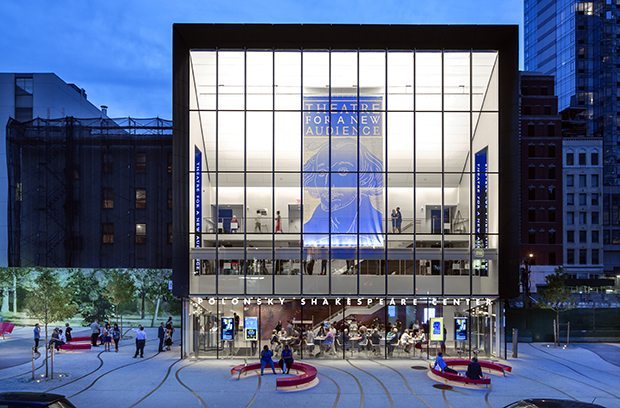
After a years-long search for a permanent venue, theatre for a New Audience rocks its stunning new digs in the rapidly-expanding downtown cultural district
by Catherine Gigante-Brown
For more than three decades, New York’s Theatre for a New Audience (TFANA) was like a troupe of drama gypsies, migrating from theatre to theatre and dependent on renting local venues for productions. In October 2013, however, came the unveiling of its new and permanent residence, the Polonsky Shakespeare Center, a conservatory-like glass cube in Fort Greene’s Cultural District.
“A building of our own has been 17 years in the making,” offered Jeffrey Horowitz, TFANA’s Founding Artistic Director.
Over the past 35 years, TFANA, a modern classical theatre rooted in Shakespeare, has staged Shakespearean dramas and comedies, along with other classic works and contemporary plays, consistently earning prestigious nominations and awards along the way, including the Drama Desk, OBIE and Tony. TFANA was also no less than the first American theatre company invited to perform Shakespeare at the Royal Shakespeare Company in Stratford-upon-Avon.
The organization’s humble beginnings were sparked by an explosive event…quite literally. Flashback to the mid 1970s, when Horowitz was working as an already accomplished classical actor—one who’d trained at the London Academy of Dramatic Art. While refinishing the wood floors of his West Village apartment, a mislabeled can of polyurethane caused an explosion, and a large fire ensued. In 1979, when the lawsuit settled, Horowitz used the resulting funds to establish TFANA. “A near-death experience turned into a happy accident,” laughed the artistic director. “I could have put the money into an annuity but took a chance and started a theatre company.” Especially in its infancy, the idea was a challenge. “I worked day and night,” Horowitz recalled. “But I was controlling my own destiny. I could actually do the kind of plays I wanted to do. At first, we didn’t perform full plays, we did ‘collages’ of Shakespeare based on a theme like love or change. We would perform anywhere we could, in small theatres, lunchrooms…community colleges.”
Early on, TFANA established a solid relationship with New York City Public Schools. It has managed to create and sustain the largest program for introducing Shakespeare, placing artists in-residence in the classroom, and bringing students to matinee performances of productions. More than 126,000 have been served since the program began 30 years ago. “But we are not a theatre company for kids,” stressed Horowitz. “Students get the same show, not a watered-down version. It offers the unique opportunity to see a diverse repertory performed by the best classical artists in the world.”
A turning point came when Horowitz met director Julie Taymor, who went on to win a Tony for The Lion King. “I thought her work was exciting but at the time she only did new plays,” he recalled. “However, I persuaded Julie to interpret Shakespeare. In 1984, she designed a 60-minute TFANA A Midsummer Night’s Dream presented by the Public Theater and in 1986, she directed The Tempest for TFANA. Both generated a lot of attention.”
To meet the demands of running a theatre company, Horowitz made the difficult decision to stop acting. “There wasn’t time to do both,” he explained. “I don’t miss it because it requires a different part of the brain. There’s grant-writing, business strategies…raising capital. Acting requires investigating the depths of a human being’s soul. You can’t just flick a switch.”
Until very recently, much of Horowitz’s time was consumed by seeking a permanent home for his company. Ground was finally broken on the Polonsky Shakespeare Center in 2011, which rose from an empty parking lot to become a neighborhood showpiece.
The artistic director worked closely with the architects, sharing his vision for the space. “It’s not a cookie-cutter process,” he added. “I visited other buildings with similar proportions, acoustics, and finishes. We didn’t want something overwhelming and ostentatious. We strove for a powerful, simple, transparent building.”
The end result is a dynamic, state-of-the-art space. With a nod to the Cottesloe Theatre of Britain’s Royal National Theatre, the 299-seat Elizabethan courtyard mainstage is the first theatre built in the city for Shakespeare and classical drama in nearly 50 years—a 27,500-square-foot, sustainable “green” structure that is both elegant and efficient. “I love the building both inside and out,” admitted Horowitz. “It’s beautifully minimal.”
Determined to attract the “new audience” of its namesake, TFANA offers the lowest reserved ticket price in the city ($20 for students and those aged 30 and under). “There’s no place like it,” Horowitz remarked proudly. “The theatre has impeccable acoustics, flexibility, and intimacy—no theatre here has all three. We wanted to create a building that communicated the primary relationship of theatre—between the artist and audience. I think we’ve accomplished that.”
Theatre for a New Audience
262 Ashland Pl. / tfana.org
An Octoroon, 2/14-3/8; The Two Gentlemen of Verona, 4/24-5/24






